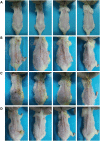Restoration of the inflammatory gene expression by horse oil in DNCB-treated mice skin
- PMID: 31940694
- PMCID: PMC7000894
- DOI: 10.4142/jvs.2020.21.e15
Restoration of the inflammatory gene expression by horse oil in DNCB-treated mice skin
Abstract
The present study evaluated the anti-inflammatory effect of horse oil in 2, 4-dinitrochlorobenzene (DNCB)-treated BALB/c mice. After the application of DNCB, the mice showed atopic dermatitis symptoms, including severe erythema, hemorrhage, and erosion, whereas those symptoms were alleviated by treatment with horse oil. To explain the anti-dermatitis effect of horse oil, the gene expression levels in the healing process in dorsal skin were observed using a cDNA microarray. The cDNA microarray analysis revealed that the expression levels of 30 genes related to the inflammation, including Ccr1, Ccr2, Ccl20, Anxa1, and Hc genes, were up-regulated (higher than 2.0-fold) in the DNCB group compared to the levels in the control group, whereas the levels were restored to the control level in the DNCB + horse oil-treated group. In contrast, the gene expression levels of 28 genes related to inflammation, including chemokine genes Ccl5, Ccl7, Ccl8, Cxcl10, and Cxcl13 genes, were down-regulated (lower than 0.5-fold) in the DNCB group compared to the levels in the control group, whereas the levels were restored to the control level in the DNCB + horse oil-treated group. Overall, the results show that horse oil restores the expression levels of genes related to inflammation that were perturbed by DNCB treatment.
Keywords: Anti-inflammatory effect; DNCB-treated mice; cDNA microarray analysis; chemokine genes; horse oil.
© 2020 The Korean Society of Veterinary Science.
Conflict of interest statement
The authors declare no conflicts of interest.
Figures






Similar articles
-
Inhibitory effect of 5,6-dihydroergosteol-glucoside on atopic dermatitis-like skin lesions via suppression of NF-κB and STAT activation.J Dermatol Sci. 2015 Sep;79(3):252-61. doi: 10.1016/j.jdermsci.2015.06.005. Epub 2015 Jun 15. J Dermatol Sci. 2015. PMID: 26100037
-
(R)-(+)-pulegone suppresses allergic and inflammation responses on 2,4-dinitrochlorobenzene-induced atopic dermatitis in mice model.J Dermatol Sci. 2018 Sep;91(3):292-300. doi: 10.1016/j.jdermsci.2018.06.002. Epub 2018 Jun 12. J Dermatol Sci. 2018. PMID: 29933898
-
Effect of Topically Applied Wikstroemia dolichantha Diels on the Development of Atopic Dermatitis-Like Skin Symptoms in Mice.Nutrients. 2019 Apr 23;11(4):914. doi: 10.3390/nu11040914. Nutrients. 2019. PMID: 31018627 Free PMC article.
-
The prevention of 2,4-dinitrochlorobenzene-induced inflammation in atopic dermatitis-like skin lesions in BALB/c mice by Jawoongo.BMC Complement Altern Med. 2018 Jul 13;18(1):215. doi: 10.1186/s12906-018-2280-z. BMC Complement Altern Med. 2018. PMID: 30005655 Free PMC article.
-
Improvement of atopic dermatitis with topical application of Spirodela polyrhiza.J Ethnopharmacol. 2016 Mar 2;180:12-7. doi: 10.1016/j.jep.2016.01.010. Epub 2016 Jan 14. J Ethnopharmacol. 2016. PMID: 26778605
Cited by
-
Regulatory role of annexin A1 in NLRP3 inflammasome activation in atopic dermatitis: insights from keratinocytes in human and murine studies.J Mol Med (Berl). 2025 Apr;103(4):435-451. doi: 10.1007/s00109-025-02529-w. Epub 2025 Mar 18. J Mol Med (Berl). 2025. PMID: 40100418
-
The beneficial effects of ethanolic extract of Sargassum serratifolium in DNCB-induced mouse model of atopic dermatitis.Sci Rep. 2024 Jun 5;14(1):12874. doi: 10.1038/s41598-024-62828-z. Sci Rep. 2024. PMID: 38834629 Free PMC article.
References
-
- Leung DY, Soter NA. Cellular and immunologic mechanisms in atopic dermatitis. J Am Acad Dermatol. 2001;44:S1–S12. - PubMed
-
- Hanifin JM, Rajka G. Diagnostic features of atopic dermatitis. Acta Derm Venereol Suppl (Stockh) 1980;92:44–47.
-
- Leung DY. Atopic dermatitis: new insights and opportunities for therapeutic intervention. J Allergy Clin Immunol. 2000;105:860–876. - PubMed
-
- Joo HA, Bae HJ, Park MC, Beak SC, Hong SH, Yang HJ, Cho HW, Jung SY, Cho JH, Hwang CY. A Clinical Study for the effect of cosmetic cream containing Samwhangsejegamibang extracts on atopic dermatitis patients. J Korean Med Ophthalmol Otolaryngol Dermatol. 2012;25:129–149.
-
- Pacor ML, Di Lorenzo G, Martinelli N, Mansueto P, Rini GB, Corrocher R. Comparing tacrolimus ointment and oral cyclosporine in adult patients affected by atopic dermatitis: a randomized study. Clin Exp Allergy. 2004;34:639–645. - PubMed
MeSH terms
Substances
Grants and funding
LinkOut - more resources
Full Text Sources
Research Materials
Miscellaneous

